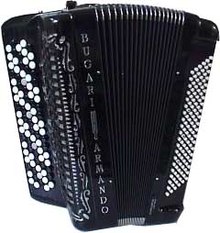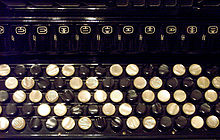Chromatic button accordion

The chromatic button accordion (in the English-speaking world: CBA for chromatic button accordion ) is an accordion instrument . The right side is fundamentally different from that of the piano accordion .
The forerunner of this instrument was the Schrammelharmonika developed in Vienna with the first B-grip arrangement on the treble side.
Modern instruments of this type essentially correspond to the Russian bayan . There are instruments with and without cassotto , an additional resonance space on the treble.
For the bass part (on the left), there are different constructions that are also used in the modern piano accordion , see bass systems .
Handle systems
The chromatic button accordion is classified into two categories according to the arrangement of the buttons, depending on whether the semitone steps increase from the outside (first row) to the inside or vice versa. The systems (C-Griff, B-Griff, G-Griff) are named after a tone that only occurs in the first (and fourth) row.
- Semitone steps increasing from outside to inside: On C-grip instruments (Italian or Swedish arrangement), the C can be found in the first (and fourth) row. On the G-grip instruments common in Finland, the G note is stored in the first (and fourth) row. The C is therefore in the third row. Technically speaking, the C-fret and the G-fret are very similar because the chord fingering patterns and the relative references of the tones are the same. The mechanics of the keyboard are also completely the same.
- Semitone steps increasing from the inside to the outside: In the case of the B-grip instruments (strictly speaking it should be called "H-grip" in German-speaking countries), which are also known as the "Norwegian arrangement", the B is in the first (and fourth) row, and the semitones increase from the inside out. This handle system is mainly used in Russia, Norway, Serbia and Belgium.
Today the treble side is usually made up of five rows of buttons, with the fourth and fifth rows repeating the first and second rows. White and black buttons correspond to the white and black keys on the piano. With buttons of the same color, buttons C and F are usually marked for better orientation (e.g. with a rough surface), sometimes also C, G and D, or, in analogy to the marked bass buttons, C, E and As. Small instruments are sometimes limited to three rows.
Exceptions that are often seen in popular music are C-handle four-rowed suits in France and B-handle six-rowed suits in the Balkans.
The fourth row simplifies the fingering of some chords (which are otherwise uncomfortable especially with the C-fingering), the fifth row basically allows the free transposability with the same fingering of passages that would otherwise be played in three rows. A sixth row basically combines both advantages. In practice, the way in which the rows are actually used by the players varies from person to person.
Also worth mentioning is the 6-plus-6 accordion, which is currently not very widespread , in which the notes are arranged in 2 rows, which has the advantage of one-dimensional melody guidance: As with the piano - and not as with the above button systems described - with the 6-plus-6 accordion, an ascending sequence of notes is always played in ascending order. In contrast to the piano, the 6 + 6 accordion also has the advantage of being freely transposable. The 6-plus-6 system can also be built as a keyboard instrument. It can also be played on the computer keyboard.
Match practice
Many accordionists play predominantly on the first three rows; the fourth and fifth rows are considered "auxiliary rows". In the advanced game, however, all rows are played equally in order to avoid unfavorable and unergonomic finger positions. Five rows also allow a playing technique that allows the same fingering pattern for all keys, provided that you limit yourself to three rows. This makes it very easy to transpose pieces of music. The invariant grip patterns also enable the experienced player to play in a very functionally oriented manner. A major chord, for example, always has the same fingering pattern, regardless of the root note it is based on. Also scales and intervals can always be played with the same fingering patterns.
Individual evidence
- ↑ Java applets for playing on the keyboard. Retrieved February 3, 2019 .


